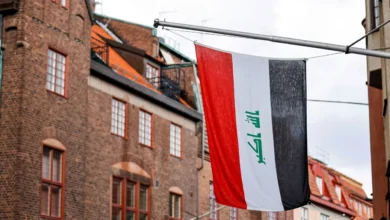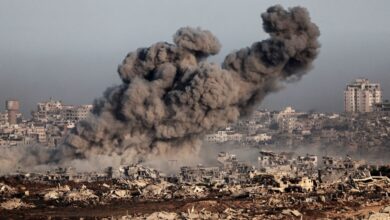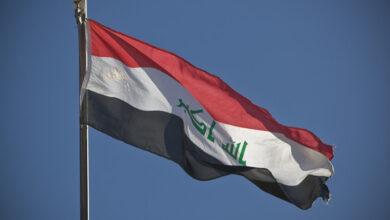
BAGHDAD — For residents of Azamiya, once one of Baghdad's most violent neighborhoods, the opening of a department store selling party dresses, imported men's suits and designer label perfumes is a sign that a better future could lie ahead.
Just five years ago, Azamiya was a terrifying place. Bodies of Shias and Sunnis butchered in sectarian killings turned up almost daily, dumped on sidewalks or in trash piles, earning one street the name "Street of Death." Fearful residents huddled at home. A US infantry company on patrol here lost 13 men to snipers and roadside bombs during the bloodiest period of 2006 and 2007.
Now the glass-fronted five-story MaxiMall department store stays open as late as midnight, and Sunnis and Shias shop side by side. Azamiya is overwhelmingly Sunni, but salespeople say they get many customers from surrounding Shia areas, drawn by colorful displays and air conditioning that offers a welcome relief from Baghdad's dusty heat.
Multilevel shopping centers are still rare in Baghdad, and the $3 million investment by the Turkish owners of MaxiMall, which opened in April, is seen as a show of confidence in Azamiya's future.
"The terrorists have failed, and Baghdad is turning into a city of life instead of being a city of death," said Umm Zaid, 45, browsing through the store with three children in tow. "It is no longer a risk to take my kids to the streets and shops."
But many fear the calm won't last.
Sunnis, though a minority in Iraq, were the dominant group under toppled dictator Saddam Hussein, a Sunni. Now they feel vulnerable to the whims of the Shia-dominated government of Prime Minister Nouri al-Maliki, who has been accused of stoking sectarian tensions by sidelining Sunni and Kurdish coalition partners.
As a former stronghold of support for Saddam and a center of Sunni pride, Azamiya feels particularly exposed, said Daoud Mohammed, a member of the Sunni local council. "Azamiya will be a target and will move backward" if sectarian violence resumes, he said. "But if the political problem is solved, Azamiya will witness a quick development."
The heavy presence of the Iraqi army is seen as a particular provocation in Azamiya. The neighborhood is cut off from the rest of Baghdad by a loop of the Tigris River and a 12-foot-high (4-meter) wall of cement slabs erected by US troops in 2007.
Five years later, army checkpoints control movement in and out of the neighborhood, with lines of cars backing up even in off-hours. Coils of barbed wire and large cement blocks close some streets. Soldiers in Humvees monitor potential hotspots, such as the Abu Hanifa mosque, perhaps the most important Sunni shrine in Iraq and a past hub for insurgents.
During Saddam's rule, middle-class Azamiya was famous for its barbecue restaurants that drew Shias, Sunnis and Kurds alike for late-night feasts of skewered lamb. The Abu Hanifa mosque was a regionally renowned center of Sunni learning and holds the remains of a revered Sunni scholar. Members of the Hashemite dynasty that briefly ruled Iraq are buried in a mausoleum on the edge of Azamiya.
On 9 April 2003, when most of Baghdad had already fallen to American troops, Saddam chose Azamiya for his last public appearance, climbing on top of a car to exhort dozens of supporters to keep fighting the invaders before he slipped into hiding. The neighborhood fell quickly, but only after a fierce battle, and eventually turned into a base for Al-Qaeda-led insurgents.
During the sectarian fighting of 2005-2007, the Sunni enclave and its outskirts became one of the main battle grounds for Sunni and Shia death squads.
Ashreen Street in Azamiya, close to the center, soon earned the nickname "Street of Death" because of the large number of bodies found there — most shot in the head execution-style, but others with signs of torture, such as nails driven through victims' limbs. Shops opened only for a couple of hours a day, and frightened residents sought refuge in their homes well before nightfall.
Major Michael Baka, who commanded Charlie Company, an infantry unit assigned to Azamiya, said that on his very first patrol in August 2006, he found a dead man in a trash pile. On a US military map that tracked where bodies were found, "my sector just blew up like a light," he said by phone from Afghanistan, his current posting. "There were dots everywhere."
Mohammed, the local council member, said about 1,000 Azamiya residents have been killed since 2003 and that some 5,000 fled, including 2,000 Shias and 3,000 Sunnis. About half the Shias have since returned, while the vast majority of Sunni refugees — generally those who were better off and settled in other countries — remain in exile.
Ahmed Mohammed, a 39-year-old real estate agent, fled with his wife and three children to Egypt in 2006, after he was threatened by insurgents for business ties with Americans. A Sunni, he returned to Azamiya for work in 2009 after he ran out of money, but keeps his family in Egypt.
"There is not a single reason that makes me optimistic about the future," he said. "There are no services and risks are high."
Amer Hasnawi, a Shia, left Azamiya in 2006, afraid to get caught by militiamen, even though he protectively carried both Shia and Sunni IDs.
"My Sunni neighbors were urging me not to leave," said the 39-year-old furniture salesman and father of two. "I told them, 'You are not going to protect me when the gunmen come to me at night or if I am arrested while walking in the street.' "
He returned in late 2007, to a warm welcome from his Sunni neighbors, and said the situation has improved dramatically. "Now there is a kind of coexistence," he said. "People discovered in the end that killings will not solve their problems."
Across Baghdad, the level of violence has dropped considerably in recent years, though insurgents from time to time still target religious sites, government officials and members of the security forces in bombings and shootings. Earlier this week, 23 people were killed in a suicide bombing outside the Shia Endowment, the office running Iraq's Shia religious and cultural sites.
Azamiya residents complain that security forces conduct frequent arrest sweeps. They believe Sunni applicants are not given a fair chance in public sector hiring and that municipal services are even worse in their neighborhood than elsewhere in Baghdad.
"I want to stay in my country, but the future is uncertain because we cannot see a ray of hope," said Hamid al-Azami, 45, a doctoral student in Islamic studies who also works as a barber in a narrow stall in the open-air market outside the Abu Hanifa mosque.
Lieutenant General Hassan Baidani, a top Baghdad security official, denied that troops are singling out Azamiya and said about half the checkpoints would be removed later this month, after an important Shia religious holiday. Mohammed Hashim, a city spokesman, said services are bad all over Baghdad, not just in Sunni areas. Since the US-led invasion, Iraqis have endured daily power cuts.
Azamiya residents reserve some of their greatest bitterness for the United States.
Mohammed, the local council member, said he bluntly told US officials during a trip by an Azamiya delegation to Washington in 2008 that "you have destroyed the country and people hate you."
Still, residents said American soldiers generally made an effort to spare neighborhood's civilians, could be reasoned with and contributed to the gradual security improvement since 2008. US troops withdrew from Iraq in December.
Major Cecil Strickland, who took command of Charlie Company in March 2007, said he believes the unit, which lost 13 soldiers over 15 months, served as a catalyst for the turnaround.
"I think we did not waste our time," he said in a phone interview from Colorado Springs, Colorado. Even then, he said, Azamiya was not without hope. "I would like to think that some of that hope has come to fruition," he said.




